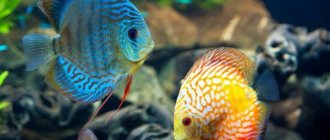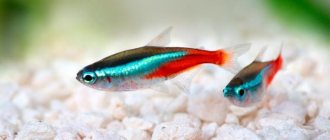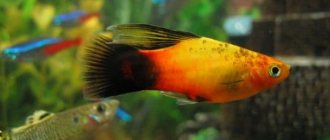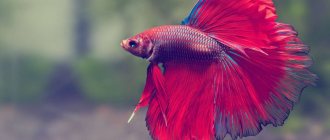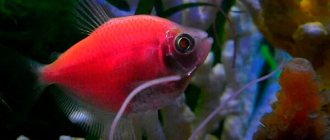SCIENTIFIC CLASSIFICATION:
Kingdom: Animals.
Type: Chordata.
Class: Ray-finned fish.
Family: Cyprinidae.
Genus: Barbs.
Scientific name: Barbus Cuvier et Cloquet, 1816.
The variety of barbs has given aquarists bright and cheerful fish, which have remained top sellers around the world for many decades. Barbs are very active, most of them unpretentious, they reproduce easily and will become a decoration for both species and general aquariums. Multi-colored, shiny, temperamental, interesting barbs have only one drawback - they are too fussy. There are also peaceful barbs, which can be kept with smaller species and not fear for the health of the latter, but the reputation of barbs as aquarium hooligans is fully deserved. Playful and fast, barbs do not tolerate slow veiled neighbors, no matter how big they are.
Habitat of barbs
Distributed in Africa, South and Southeast Asia.
Description of barbs
Most barbs are small schooling fish, measuring 4-6 cm in size. However, there are representatives reaching 35 cm. Small barbs are considered peaceful inhabitants of aquariums, but they can be aggressive to the point that they destroy other fish in the aquarium. In general, these are fast and nimble fish, constantly on the move, they are looking for something and catching up with each other. Suitable for aquarists who prefer active aquarium inhabitants.
BarbosyTOP video review
Description
The body is elongated, the caudal fin is two-lobed. The color of the scales depends on the specific species and is very diverse: you can find solid colors, with spots, transverse and longitudinal stripes. Sexual dimorphism is weakly expressed in most species. Females are usually larger, with a large rounded abdomen, but less intense coloring than males.
Barbs are characterized by a gregarious lifestyle. They simply need a group of relatives. Usually these are flocks of 6-10 individuals. But when alone, they experience severe psychological stress and may even begin to attack other inhabitants.
It is impossible not to mention the attractiveness of barbs. There are a huge number of their varieties. A flock of bright, beautiful fish, always on the move, will become a real decoration for both the general and species aquarium.
There are also no difficulties with breeding barbs. These are spawning fish and are often chosen by beginners to begin mastering the art of breeding aquarium fish.
Habitat
Barbs live in the waters of Africa and Asia; in the aquarium hobby, mainly representatives from Southeast Asia are represented. Wild populations of barbs were brought to some countries and, thanks to their hardiness, took root here without any problems. For example, some species can be found in the USA, Colombia, Australia, and Singapore.
Maintenance and care
The variety of barb species can truly surprise you. Among them there are species whose individuals grow on average up to 4-6 cm in length, and there are also those that reach a length of 30-35 cm. You should choose an aquarium based on its dimensions based on the size of adult barbs. After all, our goal is to create comfortable conditions for their living. The lifespan of barbs is that with proper care they live up to 6-7 years.
If you do not plan to keep “giants,” then an aquarium of 50 liters or more is standard for a flock of most species of barbs. Its shape is preferably elongated (i.e., a rectangular aquarium). Be sure to ensure there is a lid. These fish are very active and jumping with acceleration is not uncommon during their play. The barb can also accidentally jump out if something or someone frightens it.
Equipment
Fish love warm, well-oxygenated water. Therefore, when preparing the aquarium, the following equipment is installed:
- A compressor that will aerate the water in the aquarium. Oxygen is actually of great importance for all fish, and it is also important for plants;
- Filter for water purification. It can be internal or external. The key point when choosing is its power. If possible, you can choose a filter with additional functions, namely flow control. These fish love it when there is a strong current;
- A thermostat whose task is to maintain the optimal water temperature for barbs.
When decorating an aquarium, the best option is a natural style. Perhaps you will be inspired to come up with various ideas from the information that the habitat of these aquarium inhabitants in their natural environment is South, South-West (Borneo, Sumatra, Thailand, Cambodia) and Southeast Asia, as well as Africa. Some of them live in India and on the island of Sri Lanka. Barbs are found in equatorial Africa.
Place living plants, stones and driftwood of unusual shape and appearance in the water. Various available materials can be used to build grottoes and caves that can serve as shelter for fish.
Water
These fish are very unpretentious. They quickly and easily adapt to almost any water. Neutral or slightly acidic water is considered optimal.
Optimal water parameters:
- Quite warm with a temperature of 20-25°C.
- Acidity levels are within 6.5-7.5.
- Water hardness indicators are from 4 to 10 dGH.
Caring for fish involves a mandatory water change - about 30% of the volume. They should be done once a week. This will avoid the accumulation of harmful and dangerous fish waste products in the aquarium.
Priming
It is best to use a specialized primer with a neutral reaction. This will guarantee the safety and quality of its composition, as well as the composition of the water. In this case, sea pebbles, quartz sand (coarse) and baked clay soil are suitable. The optimal soil fraction is 2-4 mm. Please note that barbs look more contrasting and impressive against the background of dark soil.
Lighting
Another advantage of barbs, for which aquarists love them, is that they feel great in any lighting. Therefore, when organizing it, you can safely focus on the types of living plants that will grow in the aquarium and the overall design.
Plant selection
Actually, you can choose the plants to your taste. Among the most popular species, Anubias, Echinodorus, Vallisneria, Cabomba, etc. are often chosen. In this case, the planning of their landing is more important. It is recommended to zoning the space into several areas. The aquarium should have open areas where the barbs will frolic, as well as areas with densely planted plants. Such thickets will serve as a natural shelter and resting place for fish.
Adviсe
- For dark thirds, choose a light background. And bright GloFish look impressive against a dark plain background.
- Place the aquarium away from sunlight to prevent algal blooms.
- Do not turn on the aquarium lights suddenly. First, turn on the light in the room, let the fish get used to the light, after which you can turn on the aquarium lamp.
- The exact water temperature in the aquarium can be determined using an immersion thermometer. A sticker thermometer gives results with errors.
Ternetia is an interesting aquarium fish that changes color depending on its mood. When frightened, the fish's body turns dirty silver.
join the discussion
Share with your friends
It is absolutely certain that most people have thought about purchasing an aquarium with fish at least once in their lives. After all, an aquarium with colorful fish swimming in it is not only very beautiful from a design point of view, but also incredibly interesting from the point of view of acquiring new knowledge and skills. Beginning aquarists do not acquire fish breeding skills right away, so they first try to get low-maintenance fish, for example, barbs.
How and what to feed barbs?
Barbs are omnivores. To ensure a balanced diet, it is necessary to include food of both plant and animal origin in their diet. You can choose dry food for your barbs - flakes, granules. High-quality food is represented by a wide range of products of plant and animal origin. Suitable frozen foods include small bloodworms, coretra, brine shrimp, and daphnia. Live food: enchytraeus, daphnia, aulophorus, etc. A balanced, safe diet is the best option.
These fish feed in the upper or middle layers of the aquarium. Feed portions should be small. Feeding frequency – 1-2 times a day. Don’t be afraid to have a “fasting” day once a week. Barbs, as fussy as they are, are also voracious. It's better to avoid overeating.
What about compatibility?
In general, barbs are peaceful fish that get along with other types of tropical fish of similar size. They are so busy playing and having fun within their flock that, by and large, they simply do not care about the other inhabitants. Problems usually only arise with single people. Under the influence of constant stress, they can be aggressive and attack other fish.
Fans of species aquariums can safely populate it with different types of barbs. Several colorful flocks will give you real pleasure. All types of these fish are completely compatible with each other. Of course, sometimes fights between males may occur, but they do not develop into anything serious.
In a general aquarium, it is better to choose medium-sized fish as “neighbors” for barbs. They get along well with swordtails, zebrafish, platies, rainbowfish, mollies and catfish. And it is definitely not recommended to house these fidgets with angelfish, goldfish, gouramis and other types of fish with veiled, long fins and characteristic slowness. The latter may simply suffer. Barbs can even bite the fins and tails of these fish.
Aquarium fish compatibility chart (1)
Aquarium fish compatibility chart (2)
Reviews
Often, inexperienced aquarists stock thornets with fish that are unsuitable in character, which leads to injuries. It has been noticed that when kept alone, thorns become aggressive and bite the fins of their neighbors.
Ternetias are sold in many stores. The average price per individual is 175 rubles.
Popular types of barbs
Barbs are represented by a large number of different species. The choice of inhabitants for your aquarium is a matter of taste. But we want to talk a little about the most popular types of barbs, and perhaps some of them will arouse interest.
Sumatran barb (Puntigrus tetrazona)
The most famous species of barbs. Its homeland is Southeast Asia. It is often called the “striped robber” or “fish in a vest,” and all because of its special coloring and cocky character. The body of the fish is high, the head is pointed. The main body color varies from yellow to silver. A characteristic feature is four transverse black stripes crossing the body: at the base of the tail, through the dorsal fin, behind the gill covers and through the eyes. The fins and tail are often red. The head of sexually mature males turns bright red during spawning. There is an albino form: the body is yellow or light beige, the stripes are milky. A schooling fish with a rather obnoxious character. It is recommended to keep at least 6 individuals in the aquarium, otherwise they may pester their neighbors in the aquarium and bite their fins. Grows up to 7 cm.
Mossy barb, or mutant
The mossy barb is a breeding form of the Sumatran barb obtained by mutagenesis. As a result, the black stripes expanded and merged, giving the fish a rich greenish-black color with a metallic sheen and red fins. Otherwise, there are no differences in appearance and content from the Sumatran barb. They look great in the same aquarium with ordinary Sumatran barbs and albinos. The fish are alive and active; it is necessary to provide free space for swimming in the aquarium. Maximum size – 7 cm.
Fire barb (Pethia conchonius)
The aquarium species grows up to 8 cm. Oval body. The sides and belly of the fish have a characteristic fiery tint; the back of the male has a brilliant olive green color. These fish have a dark spot with a gold-colored edging in the front of the caudal peduncle.
Shark barb (Balantiocheilus melanopterus)
An adult barb can grow up to 35 cm. The body is compressed on the sides and is quite narrow. Its shape gives it a resemblance to a shark. The general color is steel-silver, the fins are darker.
Denison barb (Puntius denisonii)
They grow up to 10 cm. Their body has an oblong shape with a silver-golden base color. A black stripe runs across the entire body along the lateral line, and a red stripe above it near the dorsal fin. The tail is forked and on its “blades” there are transverse stripes of black and yellow. Today in the natural environment they are on the verge of extinction.
Cherry barb (Puntius titteya)
A very bright, beautiful red fish with a line on the side of its body marked with black dots. While moving, it literally merges into one continuous thing. Adults grow up to 4 cm.
Five-stripe Barbus (Desmopuntius pentazona)
As the name suggests, the body of the fish has 5 vertical stripes of black color on an overall red-brown color. These fish grow up to 5 cm in length.
Cross barb (Puntius lateristriga)
It has an original pattern: in the front part of the body there are two fuzzy vertical black lines, and in the back there is one longitudinal stripe of black and blue color. The general color on the sides is yellowish-brown, on the back it is olive-green with a reddish tint, and the belly is orange.
Barbus butterfly, barbus moth (Barbus hulstaerti)
The size of the fish is only 3.5 cm. The overall color is light brown with a brown back and yellowish fins. And the main highlight is the dark shiny spots located on the side.
Interesting Facts
Many subspecies of Barbus are often capable of mutual crossing and the birth of new offspring with interesting color morphs.
Barbs still amaze ichthyologists and aquarists with their variety of colors, shapes, sizes, behavioral styles and intelligence.
From illness, from stress, and with age, the bright color can turn pale and completely discolored.
Russian aquarists first began keeping these pets only in 1946.
A single Barbus behaves timidly in an artificial reservoir, hides in algae, but, as a rule, dies very quickly. A flock of several individuals plays happily and plays pranks.
Some varieties of Barbus are real aquarium long-livers and live more than 10 years, for example, Shark Baloo.
BARBUS SOLAR
BARBUS PINKID
BARBUS OLIGOLEPIS OR ISLAND BABBLE
BARBUS COZUATIS
YELLOWFIN PEARL BARBUS
BARBUS LONG-STRIPED
FIVE STRIPED BARBUS
BARBUS OLIVE
BARBIES OF SRI LANKA
AFRICAN BARBS
LARGE BARBES
SCHUBERT'S BARBUS
BARBUS DENISONI
LADY BARBUS
BARBUS GOLDEN BARBUS MOSSY, BARBUS TIKTO, BARBUS MUTANT
BARBUS FOUR LINE
BARBUS BLACK
BARBUS OLIGOLEPIS
BARBUS LATERISTRIGA
SHARK BALA
SUMATRAN BARBUS
BARBUS SCARLET
BARBUS ARULIUS
BARBUS BUTTERFLY
BARBUS CHERRY
BARBUS TWO-POINT
BARBUS GREEN
BARBUS CLOWN
Breeding and propagation of barbs
There are differences in breeding for different types of barbs. We propose to consider the process using the example of the Sumatran barb.
Preparing producers for spawning
Determining the female and male before the onset of sexual maturity (6-10 months) is not easy. Females are larger and have a more rounded abdomen. Males have brightly colored fins and faces.
You should choose the most beautiful fish for spawning. Manufacturers must have bright, rich colors, there must be no defects or curvatures of fins, various outgrowths and other non-standard features.
It is considered normal for barbs to spawn twice a year. Its regularity has a beneficial effect on the health of females. And if such frequency is violated, then the risk of developing malignant tumors is high.
About a week before the planned spawning, selected spawners should be placed in different containers - females and males separately. The diet of the fish also changes during this period - it should include plant and high-protein foods; feeding with live food brings good results, this stimulates the fish to produce eggs and milk.
A signal that the female’s eggs are ripe will be a swollen anus and a significantly rounded tummy. While the breeders are separated, a spawning aquarium should be prepared. In a community aquarium, successful reproduction is impossible, and the parents should subsequently be separated, since barbs are devoid of any maternal instincts and can feast on eggs or fry.
What conditions must be created for barbs to spawn?
As a spawning aquarium, a 10 liter capacity is sufficient, depending on the size of the fish and the number. Water can be taken from a common aquarium by adding only part of the fresh water (ratio 2:1).
At the bottom you should organize a kind of shelter that will protect the laid eggs; it is better to use a separator mesh, because it is easy to remove after spawning, after which the care of eggs and fry is greatly simplified.
For the first stage of spawning, connecting devices for filtration and aeration is not required. What may really be required is a slight heating of the water. Spawning is stimulated by raising the water temperature to 26-28 degrees and adding soft, fresh water.
How does spawning occur?
The whole process takes place at dawn. Therefore, it is better to plant the breeders in the spawning aquarium in the evening. The ratio is 2 males per female. You should watch the fish for a while. If you notice strong conflicts, then it is better to replace the bully.
Spawning occurs in the morning, the male actively chases the female and lightly hits her with his head, as a result, eggs fall out, which he then fertilizes. The number of eggs can be several hundred.
Spawning lasts for a couple of hours; after the process is completed, the spawners immediately leave. If the female’s belly is still enlarged and there is still some caviar there, then it should be very carefully expressed, but this is best done if you have experience.
When only eggs remain in the aquarium, you can further reduce the volume of water in the spawning tank to 10 cm. At this stage, you can add light aeration and methylene blue (an antifungal drug) to prevent the appearance of fungus on the eggs. Next, you should inspect them - dead eggs will be white (they are carefully removed), and healthy ones will be transparent.
Diseases
Characins have good health. If maintained incorrectly, they encounter standard diseases:

